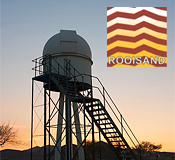 |
ROOISAND OBSERVATORY DeepSky | SITEMAP HOME ROOISAND |
|
 |
|||
| « back to overview Star Clusters | Load higher resolution (1900 x 1300 Pixel) | Object description |
The emission nebula NGC 6164/6165 surrounds the unusual massive (40 sun masses) star HD 148937. It is a very hot multiple star system (triple maybe quadruple). HD 148937 shines about 25.000 times as strong as the sun and rotates very fast. It could be a Wolf-Rayet-Star which is about to transition to a new development phase. The nebula itself consists of gas masses which HD 148937 emitted during an eruptive phase. Now they are excited to emit light because of the stars strong UV radiation. In the high-resolution version one can see a second further-out nebula shell towards the left edge of the image, which might have been created by a prior active phase of the star. The age of the brighter part of the nebula is estimated to be ca. 200.000 years.
The distance to NGC 6164/6165 is 4200 light years. With an apparent diameter of 3 x 6 arc minutes in the sky, the nebula extends to an area of 4.2 light years in space. The two brightest nebula areas, lying symmetrical to its central star, both received a separate NGC number – so that the nebula now has this double identifier. The image field of the linked high resolution picture corresponds to about the size of the half-moon area.
 |
NGC
6164/65 is located in a quite colorful region within the constellation Norma.
The picture shows a mosaic of two fields. On the left side of the picture is
NGC 6193, a very compact open star cluster. Right of the vertical shock front
(NGC 6188) is an active star birth region. NGC 6164/65 is in the right upper
corner of the mosaic. The picture was also taken at Rooisand in 2009. The telescope used was a 6" APQ Refractor with AP Reducer at 900mm focal length. « Load the big picture (2000 x 1200 pixel). More information about the picture here. |
The surface temperatures are between 25.000 and 50.000 Kelvin, their masses are between 10 and 50 sun masses and their luminosity is between 100.000 times and million times stronger than our sun. The high temperature creates high radiation pressure leading to strong stellar wind which causes a strong mass loss. It is estimated to be about 3 sun masses per one million years on average (up to 1 sun mass per a few thousand years in an extreme case). That is way Wolf-Rayet stars are often times connected to nebulas. They are very young stars and their life expectancy cannot be very long because of the strong mass loss – some ten millions of years at max.
The Wolf-Rayet star HD 148 937 might be at the transition from a WR-star to a new development phase; some stars in IC 2984 (Carina) and in NGC 3606 (Carina) are Wolf-Rayet stars. The most famous examples for observers at the northern hemisphere are NGC 6888 (Crescent nebula) and NGC 2359 (Thors Helmet) in the constellation Canis Majoris. There are just nearly 200 stars know overall and 23 of them are variable.
 |
 |
 |
 |
 |
| Moon | Solar System | DeepSky | Widefield | Miscellaneous |